|
|
4 Late 19th century - Middle Class
Towards the late nineteenth century, substantial improvements were made in
the provision of services in urban housing although, inevitably, the benefits
were more apparent in the middle class house. The most striking advance was the
rapid adoption of the bathroom with fixed appliances supplied with running hot
and cold water in larger houses after 1870. The coming of the bathroom
represented a major change to the layout of the first floor plan rendering the
traditional dressing room obsolete; it also had a huge impact on the way people
lived and kept themselves clean. The key was the greater availability of mains
water. During the 1860s and 1870s most towns and cities acquired constant
supplies of pressurised, filtrated water either through municipally run concerns
or through private companies. The practical difficulties of filling a full
length bath were lifted once a connection to a mains supply was laid on. Fitted
to a cold supply only, the bath water was heated by a small solid fuel or gas
stove fixed to one end of the tub or by a gas burner attached underneath.

It
could take half an hour for the water to heat up but following the invention of
the geyser by Benjamin Waddy Maughan in 1868, scalding hot water could be had
instantaneously. The geyser consisted of a copper cylinder in which finely
divided streams of water were heated by the rising hot gasses from rows of gas
jets in the base.
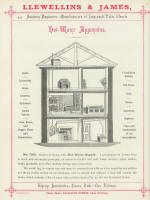 |
The obvious disadvantage with the geyser and other similar heaters was that
the hot water was usually confined to just one appliance. However, after1850,
many larger households acquired closed fire ranges fitted with a back boiler
which circulated hot water to a storage tank through flow and return pipes. This
enabled hot water to be drawn off at any number of points in the house,
including the kitchen or scullery, the bathroom and bedrooms. The earliest
arrangement was known as the tank system and consisted of a circuit of flow and
return pipes connecting the kitchen range boiler at the lowest point to a hot
water tank at the highest point of the system and usually placed in the roof.
The tank system was inefficient with heat loss a major problem but it also
possessed one lethal weakness. Since all the taps were situated below the hot
water tank it was possible to draw off water at the lowest point until the flow
pipe was nearly empty so that any remaining water in the range boiler evaporated
and it became red hot. If any water returned to the empty boiler it immediately
turned to steam causing a rapid increase in pressure in the boiler which was
sometimes enough to cause a catastrophic explosion. By the 1880s, the cylinder
system had appeared as a safer and more efficient alternative. In place of the
hot water tank in the roof, a hot water storage cylinder was placed just
slightly above the range. The hot water was drawn off from the expansion pipe
that extended upwards from the top of the cylinder to above the cold-water tank
so there was no risk of the system being inadvertently emptied. |
 |
Bathroom fittings of the 1870s and 1880s were usually enclosed in mahogany
panelling which provided some visual unity to the bath, washbasin and WC. From
the mid-1880s, health reformers promoted the use of freestanding appliances that
could more easily be kept clean. Cast-iron baths made with decorative feet and
roll-top rims became popular in the 1880s along with washbasins supported by
ornate stands of cast-iron and then in 1884, the new all-ceramic pedestal WC
made its debut at the International Health Exhibition, South Kensington. The
first pedestal WCs were of the wash-out type in which a shallow reserve of water
was held back in the upper basin, separate altogether from the water in the trap
below. Wash-out closets, however, proved to be difficult to flush and soon gave
way to the wash-down closet which had just one level of water created by placing
the trap at the back of the basin instead of underneath. The wash-down WC was
easier to flush than other closets with the two gallon limit imposed by most
water authorities on WC cisterns and by the early 1900s, the pedestal wash-down
was established as the standard toilet for the middle classes. By the 1870s - in
time for the adoption of the bathroom by the better off - many towns and cities
had invested in the creation of sewerage systems so that the new bathrooms were
connected to house drains which in turn led to sewers in the street. By the time
the 1875 Public Health Act was passed, the urban cesspool was rapidly becoming a
thing of the past. |
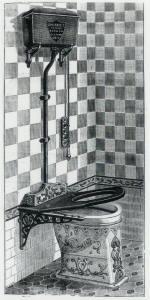 |
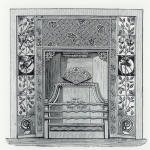 |
Gas and coal continued to provide the main sources of energy in the home
throughout the second half of the nineteenth century. After the 1870s the design
of both coal burning ranges and open fireplaces was directed towards improving
fuel efficiency. Slow combustion grates set low on the hearth within a low and
narrow rectangular opening were introduced about 1870. Decorative glazed tiles
which suited the prevailing fashion amongst the well to do for ‘aesthetic’
interior décor were often incorporated in the fireplace surround. By the1890s
the sixteen inch wide bottom grate had become a trade standard and most
fireplaces were fitted with ornate adjustable canopies to regulate the draught.
By the 1890s, it was usual for virtually all good quality closed ranges to
incorporate sliding and folding panels over the grate so that they could be
quickly and easily converted to open fires when cooking was over in order to
save fuel. |
 |
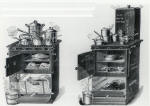 |
Between 1850 and 1900, the price of gas halved and by 1885 there were about
two million gas consumers in England and Wales. Lighting was still the chief
domestic application of gas but several important innovations brought a wider
range of gas appliances into the middle class home in the late nineteenth
century. The use of gas for heating bath water largely rested on the
introduction of Dr Bunsen’s atmospheric burner in the 1860s. By combining air
with the gas, the Bunsen burner transformed the yellow, luminescent flame into a
hot blue flame capable of generating considerable heat. Atmospheric burners were
also applied to cookers, heating stoves and even laundry irons. The use of gas
for cooking had to overcome the innate conservatism of the average middle class
householder – and of their cooks - but from the mid-1880s, gas companies began
to stage cooking demonstrations to overcome popular prejudices. The result was a
significant rise in cooking by gas at the end of the century and in Bristol, for
example, gas cookers were used in 40% of households by 1908. |
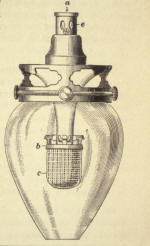 |
From 1885, gas lighting was improved following the development of the
incandescent light by the Austrian, Carl Auer, Baron von Welsbach. His light
worked on an entirely new principle. Whilst the light of flat flame and Argand
burners was produced by raising the carbon particles in the gas to incandescence
– that is, the flame produced the light - Welsbach used the atmospheric or
Bunsen burner to create a hot blue flame. This gave no light itself but raised
to incandescence the oxides of two rare metals: thorium and cerium in the
proportion of 99% and 1% respectively. The incandescent gaslight was at least
ten times more efficient than conventional burners although the use of the lamps
at first was hampered by the difficulty of replacing the extremely fragile
mantles impregnated with the two rare metals. From about 1905 inverted
incandescent burners became available: these had the advantage that the light
shone downwards without creating a shadow. Incandescent lighting by electricity
actually predates its application to gas, having been introduced by Edison and
Swan in 1879. Electricity for private use was first generated in Brighton and in
Holborn in 1882 followed by parts of Kensington in 1887 but progress was slow
and in 1910 only 2% of British homes had electricity. |
|
|







